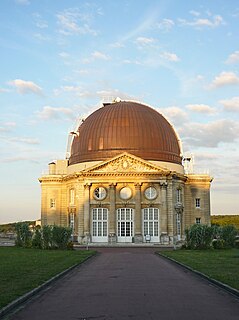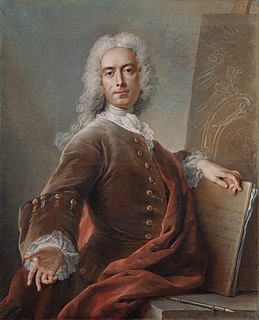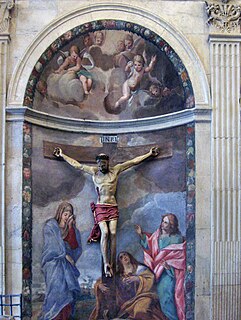Coypel is the name of a French family of painters, including:
- Noël Coypel 1628–1707,
- Antoine Coypel, 1661–1722, son of Noël
- Charles-Antoine Coypel 1694–1752, son of Antoine
- Noël Nicholas Coypel 1690–1734, son of Noël and half-brother of Antoine
Coypel is the name of a French family of painters, including:

Antoine Coypel was a French painter, pastellist, engraver, decorative designer and draughtsman. He became court painter first to the Duke of Orléans and later to the French king. He became director of the Académie Royale. He was given the title of Garde des tableaux et dessins du roi, a function which combined the role of director and curator of the king's art collection. He was raised to the nobility by the French king. He is known for his history paintings, biblical, mythological and allegorical works, portraits and genre scenes.

Noël Coypel was a French painter, and was also called Coypel le Poussin, because he was heavily influenced by Poussin.

Noël-Nicolas Coypel was a popular French artist.

Jean-Baptiste Lemoyne was a French sculptor of the 18th century who worked in both the rococo and neoclassical style. He made monumental statuary for the Gardens of Versailles but was best known for his expressive portrait busts.

Meudon Castle, also known as the Royal Castle of Meudon or Imperial Palace of Meudon, is a French castle located in Meudon in the Hauts-de-Seine department. At the edge of a wooded plateau, the castle offers views of Paris and the Seine river, as well as of the valley of Chalais. Located between Paris and Versailles, in the heart of a hunting reserve, the castle has an ideal topography for large gardens. It had many successive owners from the Renaissance until the fall of the Second French Empire. It should not be confused with the Bellevue Castle, also located in Meudon.

François Lemoyne or François Le Moine was a French rococo painter. He was a winner of the Prix de Rome, professor of the Académie de peinture et de sculpture, and Premier peintre du Roi to Louis XV. He was tutor to Charles-Joseph Natoire and François Boucher.
Events from the year 1707 in art.
Vernet is a surname. Notable people with the surname include:

Charles-Antoine Coypel was a French painter, art commentator, and playwright. He became court painter to the French king and director of the Académie Royale. He inherited the title of Garde des tableaux et dessins du roi, a function which combined the role of director and curator of the king's art collection. He was mainly active in Paris.

The Embarkation for Cythera is a painting by the French painter Jean-Antoine Watteau. It is also known as Voyage to Cythera and Pilgrimage to the Isle of Cythera. Watteau submitted this work to the Royal Academy of Painting and Sculpture as his reception piece in 1717. The painting is now in the Louvre in Paris. A second version of the work, sometimes called Pilgrimage to Cythera to distinguish it, was painted by Watteau about 1718 or 1719 and is in the Charlottenburg Palace, Berlin.
Arthena is a French Association pour la diffusion de l'histoire de l'art which regularly publishes art history books and most particularly catalogues.

Noël Quillerier was a French painter who also served as a valet de chambre for the king. A native of Orléans, in 1631 he married Charlotte Lerambert, the sister of sculptor Louis Lerambert. Their daughter Marguerite married the sculptor Antoine Coysevox; their son Jérôme, baptized February 19, 1639, was also listed as a painter, though none of his works are known to have survived. Among Quillerier's pupils was Noël Coypel. He died in Paris.
Dugès is a surname. Notable people with the surname include:
Jean Audran (1667-1756) was a French engraver and printmaker. The brother of Benoit, and the third son of Germain Audran, he was born at Lyons in 1667. After learning the rudiments of the art under his father, he was placed under the care of his uncle, the famous Gérard Audran, in Paris. Before he was twenty years of age he displayed uncommon ability, and became a very celebrated engraver. In 1706 he was made engraver to the king, with a pension and apartments at the Gobelins. The hand of a great master is discernible in all his plates; and without having attained the extraordinary perfection of Gérard Audran, his claim to excellence is very considerable. He died in 1756. His principal prints are:
Gaspard Duchange (1662–1757) was a French engraver.

Nicolas-Henri Tardieu, called the "Tardieu the elder", was a prominent French engraver, known for his sensitive reproductions of Antoine Watteau's paintings. He was appointed graveur du roi to King Louis XV of France. His second wife, Marie-Anne Horthemels, came from a family that included engravers and painters. She is known as an engraver in her own right. Nicolas-Henri and Marie-Anne Tardieu had many descendants who were noted artists, most of them engravers.

The Musée Bossuet is the art and history museum of the town of Meaux, France. Situated in the old episcopal palace, it takes its name from the famous orator and theologian, Jacques-Bénigne Bossuet, Bishop of Meaux from 1681 to 1704.

François Dumont was a French sculptor.
Renée-Élisabeth Marlié was an 18th-century French engraver.

Christine Antoinette Charlotte Desmares, professionally known as Mlle Desmares, was a French actress. Scion of a notable comic actors family, she had an active stage career that spanned three decades, performing with the Comédie-Française from 1699 until her retirement in 1721; she was also remembered as a mistress of Philippe II, Duke of Orléans, Regent of France.